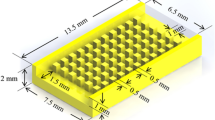Abstract
This paper deals with heat exchangers having plain finned tubes in staggered (triangular) pattern. The objective of this paper is to provide the heat transfer and friction factor correlation which can be used in engineering practice. For this purpose, the experimental data of several (most cited) authors who deal with this type of heat exchangers are used. The new correlations are established to predict the air-side heat transfer coefficient and friction factor as a function of the Reynolds number and geometric variables of the heat exchanger – tube diameter, tube pitch, fin spacing, tube rows, etc. In those correlations the characteristic dimension in Reynolds number is calculated by using the new parameter – volumetric porosity. Also, there are given the errors of those correlations.





Similar content being viewed by others
Abbreviations
- d c :
-
collar diameter, m
- d h :
-
hydraulic diameter, m
- f :
-
Fanning friction factor
- H :
-
height of a heat exchanger channel, m
- j H :
-
Colburn heat transfer factor
- L :
-
length of the heat exchanger, m
- \( \dot{m} \) :
-
fluid flow rate, kg/s
- N l :
-
number of tube rows
- Nu:
-
Nusselt number
- Pr:
-
Prandtl number
- Re:
-
Reynolds number based on hydraulic diameter
- s f :
-
fin pitch, m
- S HE :
-
air side heat exchange surface area (total outside surface area), m2
- s l :
-
longitudinal tube pitch, m
- s t :
-
transversal tube pitch, m
- S uf :
-
unfined surface area (area of bare tubes between fins), m2
- s V :
-
specific surface, m2/m3
- \( \dot{V} \) :
-
fluid volume flow rate, m3/s
- V f :
-
heat exchanger free volume, m3
- V HE :
-
volume of heat exchanger chamber, m3
- W :
-
width of a heat exchanger channel, m
- w f :
-
air velocity at the front of the heat exchanger, m/s
- w ε :
-
air velocity reduced to the porous cross-section of the exchanger, m/s
- z :
-
number of experimental regimes (runs)
- α :
-
heat transfer coefficient, W/(m2∙K)
- ∆p HE :
-
pressure drop, Pa
- δ :
-
fin thickness, m
- ε :
-
volumetric porosity, m3/m3
- λ :
-
thermal conductivity, W/(m∙K)
- μ :
-
dynamic viscosity, Pa∙s
- ρ :
-
average fluid density, kg/m3
- ξ :
-
Weisbach (Dracy) friction factor
- PD:
-
pressure drop
- HT:
-
heat transfer
References
Kays WM, London AL (1973) Compact heat exchangers [*in German]. Akademie–Verlag, Berlin
Rich DG (1973) The effect of fin spacing on the heat transfer and friction performance of multirow, smooth plate fin-and-tube heat exchangers. ASHRAE Trans 79(2):137–145
Rich DG (1975) The effect of the number of tube rows on heat transfer performance of smooth plate fin-and-tube heat exchangers. ASHRAE Trans 81(1):307–317
McQuiston FC, Tree DR (1971) Heat-transfer and flow-friction data for two fin-tube surfaces. J Heat Transf 93:249–250
McQuiston FC (1978) Heat, mass and momentum transfer data for five plate-fin-tube heat transfer surfaces. ASHRAE Trans 84(1):266–293
McQuiston FC (1978) Correlation of heat, mass and momentum transport coefficients for plate-fin-tube heat transfer surfaces with staggered tubes. ASHRAE Trans 84(1):294–309
Haliçi F, Taymaz I, Gunduz M (2001) The effect of the number of tube rows on heat, mass and momentum transfer in flat-plate finned tube heat exchangers. Energy 26:963–972
Eckels PW, Rabas TJ (1987) Dehumidification: on the correlation of wet and dry transport processes in plate finned-tube heat exchangers. J Heat Transf 109:575–582
Tang LH, Min Z, Xie GN, Wang QW (2009) Fin pattern effects on air-side heat transfer and friction characteristics of fin-and-tube heat exchangers with large number of large-diameter tube rows. Heat Transfer Eng 30(3):171–180
Liu YC, Chen IY, Hu R, Wang CC, Yang BC (2008) Sensible airside performance of fin-and-tube heat exchangers – data with larger diameter tube. ASHRAE Trans 114(1):379–386
Wang CC, Chi KY (2000) Heat transfer and friction characteristics of plain fin-and-tube heat exchangers, part I: new experimental data. International Journal of Heat and Mass Transfer 43(15):2681–2691
Jacimovic BM, Genic SB, Latinovic BR (2006) Research on air pressure drop in plate finned tube heat exchangers. Int J Refrig 29:1138–1143
Kayansayan N (1993) Heat transfer characterization of flat plain fins and round tube heat exchangers. Exp Thermal Fluid Sci 6(3):263–272
Wen MY, Ho CY (2009) Heat-transfer enhancement in fin-and-tube heat exchanger with improved fin design. Appl Therm Eng 29(5–6):1050–1057
Lelea D, Cioabla A (2010) The viscous dissipation effect on heat transfer and fluid flow in micro-tubes. Int Commun Heat Mass Transfer 37:1208–1214
Author information
Authors and Affiliations
Corresponding author
Additional information
Publisher’s Note
Springer Nature remains neutral with regard to jurisdictional claims in published maps and institutional affiliations.
Appendix
Appendix
The comparison of experimental (ym,i) and correlated (yc,i) parameter can be done by certain number of statistical parameters:
-
standard deviation
-
the mean relative error
-
the maximal positive error
-
the maximal negative error
-
correlation ratio
where ym,av is the average value of ym for complete set of z experimental data
\( {y}_{m, av}=\frac{\sum \limits_{i=1}^z{y}_{m,i}}{z} \)
Rights and permissions
About this article
Cite this article
Otović, M., Mihailović, M., Genić, S. et al. Reconsideration of data and correlations for plate finned-tube heat exchangers. Heat Mass Transfer 54, 2987–2994 (2018). https://doi.org/10.1007/s00231-018-2328-0
Received:
Accepted:
Published:
Issue Date:
DOI: https://doi.org/10.1007/s00231-018-2328-0




